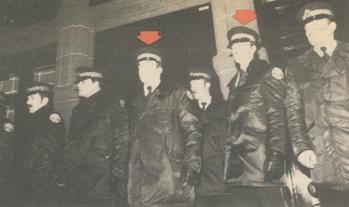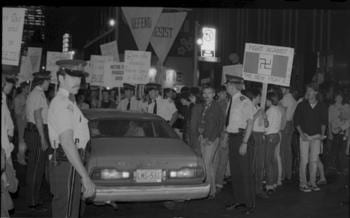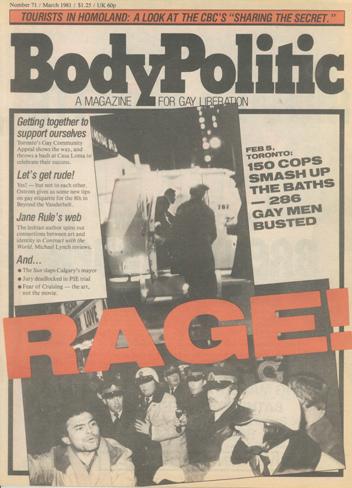
In one night, police charge hundreds of men with being found in a common bawdyhouse. Credit: (Gerald Hannon)

Toronto police, two with missing badges, on the steps of the Ontario legislature on Feb 6, 1981. Credit: (Gerald Hannon)

A rally in the streets of Toronto on June 20, 1981, turns ugly. Credit: (Gerald Hannon)

At the June 20 demonstration, protesters burn effigies of then-Ontario attorney general Roy McMurtry and Toronto police chief Jack Ackroyd. Credit: (Gerald Hannon)
This is a part of Xtra’s special coverage – videos, audio clips, photos and printed stories – looking back on the 1981 bathhouse raids and riots.
Late on the evening of Thursday, Feb 5, 1981, hundreds of Toronto police conducted simultaneous raids on four of Toronto’s most popular bathhouses, arresting more than 300 men. Conceived to send the city’s newly visible gay community back to where it had come from, Operation Soap teetered on the edge of success. Fearing the worst but hoping for the best, activists who had shepherded their community’s hesitant emergence as a political force called for a public protest the next evening at Yonge and Wellesley streets.
Writer Gerald Hannon was at the centre of it all and recorded what he witnessed in The Body Politic, the city’s gay newsmagazine. Thirty years later, his words remain a vivid testament to a breaking storm of anger and courage that remade our communities.
______
Friday night, Feb 6
It is the night when 3,000 people come within minutes of breaking down the doors of the Ontario legislature.
It is the night the main street of Canada’s largest city belongs to us, and nobody — not even the police — seems to be able to do anything about it.
It is midnight, Feb 6 — just 24 hours after the largest mass arrest since the 1970 invocation of the War Measures Act.
* * *
Yonge and Wellesley is an intersection at the heart of what has come to be known as Toronto’s gay ghetto. It is also one of the busiest intersections downtown. By midnight there are probably 300 people here, blowing whistles, brandishing homemade signs, chanting “No more raids!” and “Stop the cops!”
Half an hour later that number has swollen to 1,500, and with the first illegal step into the intersection the street is ours.The police, undermanned and apparently unprepared, can do little but reroute traffic.
Civil disobedience is in the air; people are drunk on the prospect of it, on the prospect of power over turf we’ve liked to say belongs to us, but realize is ours only grudgingly, and on loan.
South. It is a change in plans. Rally organizers intended to head north to police headquarters at 590 Jarvis St, but the mood of the crowd is inexorably south, where Toronto can see us.
South. Into the heart of the city and towards police 52 Division — the concrete and glass fortress that only hours before held hundreds of frightened and angry men.
This video is an excerpt from the documentary film Track Two. In it Hannon describes covering the bathhouse raids for Xtra‘s predecessor, The Body Politic.
The scene is surreal. Yonge St, usually a river of bumper-to-bumper traffic, is an empty canyon echoing to the shouts, screams and whistles of an advancing crowd the full width of the street. The occasional car the police haven’t stopped somehow makes it onto the street, stops, can’t turn around, gets swallowed up. A man jumps up onto the roof of one of them and does a disco turn before leaping back into the crowd.
* * *
The first signs of trouble come just north of Dundas St.
Cop cars are parked in the middle of the street, angled to form a kind of barricade. It doesn’t work. A few sharp blows and a windshield cracks. Two men stand and piss on one of the cars.
Suddenly there is a scuffle. It seems a straight man has attacked one of the marchers. A cop tries to intervene and all hell breaks loose — the crowd apparently thinks the cop is the attacker and surges at him, fists flying. Three other cops try to force themselves through the crowd but simply end up being trapped with the first one, pinned against a store wall, hopelessly outnumbered but fighting back until enough marshals force their way in and break it up.
The atmosphere gets uglier — by this time the march has attracted a peripheral crowd of 20 to 30 straight men. As the crowd surges toward 52 Division chanting “Fuck you, 52! Fuck you, 52!” the straight men counter with “Fuck the queers! Fuck the queers!” In a final desperate and quixotic gesture they link arms and try to block University Ave. By this time it’s 30 against 3,000 and it’s no contest — a short scuffle, and they scatter.
We reach 52. The stabbing lights of the TV cameras pick out an astonishing sight — cops, about 200 of them, standing shoulder to shoulder completely surrounding the front of the building. Our line surges up and slaps against theirs, but theirs doesn’t break — even when the crowd gives them the Nazi salute, even when the crowd spits in their faces.
* * *
There is one target left. Queen’s Park. The Ontario legislature is a scant 10 minutes away and the focus of a particular hatred in the last six weeks since all three political parties backed away from an opportunity to legislate human rights for gay people.
The crowd seethes up University Ave, and the front line of marshals is having more and more difficulty trying to contain it. They link arms, stretching themselves across the front, but as the thousands of marchers take their first steps onto the vast expanse of lawn that sweeps up to the legislature, the front line crumbles and nothing can hold people back. They run, hundreds of black figures against the snow, heading straight for the massive oak doors of our legislative assembly.
They get there before the cops do, and for a few thrilling minutes, dozens of bodies throw themselves repeatedly against the doors. Even people halfway back in the crowd report seeing the doors vibrating in the probing light of the television cameras and hearing the hollow booming of bodies thudding against the barriers.
A wedge of some 20 officers forces its way through the crowd, and punching, kicking, shoving, they beat the crowd back. One man’s face is bloodied. Another man is shouting that his sister has been hit over and over again by a cop.
* * *
The ugliest scenes of the night are reserved for Yonge and Bloor — by this time, cops and straight thugs far outnumber what few marchers are left. The straights are shouting insults, and I watch as half a dozen cops completely surround a man, drag him to the ground and begin kicking and punching. A TBP photographer who tries to photograph the scene is hauled to the ground by his hair, his flash attachment smashed, his glasses broken. He is later charged with breach of the peace.
It is about 2:30am, Saturday, Feb 7. Eleven people have been arrested during the last two and a half hours — two for assaulting a police officer, one for damage to public property, one on a drug charge and seven with breach of the peace.
One policeman was slightly injured. At least one cop car had its windshield cracked and its headlights kicked in. A streetcar had four of its windows smashed. But most of the damage was on the other side.
Toronto police continued to pummel our community with arrests and raids in the months that followed. Far from tamping down the uprising, every new act of police aggression seemed to send more waverers out of the closet and into the streets. A second protest, larger and more orderly, took place on Feb 20. An indoor Gay Freedom Rally drew more than a thousand to St Lawrence Market on March 6. More bathhouse raids on June 16 precipitated another peaceful protest and a final, violent clash on June 20.
* * *
Saturday night, June 20
Although the demonstration of June 20 is peaceful, the events that come after are not.
As the demonstration breaks up, about 500 people walk west along Charles St. The crowd is in an aggressive mood; the closing chant of the rally, “Never again, never again” is still in the air.
As they pass cops standing on the south side of headquarters, some of the departing demonstrators chant, “The cops and the Klan go hand in hand.” And a trio of police officers responds with their own chorus: “Faggots and faggots go hand in hand.”
Part of the crowd has already passed the intersection of Charles and Church streets at about 12:10am when a squad of about 10 queerbashers emerges from Hayden St. They run south on Church toward the crowd, swinging lengths of wood and shouting obscenities. A call for marshals brings a number to the scene. They and others quickly link arms between the bashers and their targets. After several feints, one of the thugs strikes a man with his weapon. Another hurls a piece of lumber into the crowd.
Furious, the dispersing demonstrators begin to chant, “Kill them, kill them.” Outflanking the marshalling line, they move to surround their attackers.
The would-be queerbashers turn and flee north on Church, most abandoning their weapons as they go. About 50 pursuers go after them. And at about the same time the cops, who are just a block away at police headquarters, begin to show up. They run up Church, pursuing the pursuers.
What happens now is somewhat clouded. There seems to be a scuffle halfway up Church to Bloor, involving at least one queerbasher, one gay man and several cops. The body of the crowd has begun to advance to the scene and shouts of “Bust him, bust him” fill the night air. Along the north perimeter of the crowd, a new marshalling line quickly forms, again made up partly of marshals from the demonstration and partly from other demo participants. As the line hardens and arms begin to interlink, more police arrive. They form their own line, shoulder to shoulder, face to face with the angry crowd, about a metre from its northern edge.
An angry voice screams, “Where were you?” underlining the fact that the police have been ostentatiously absent while gays were being attacked but are able to muster strength in a few seconds to rescue the criminals from the revenge of their victims. Instantly it becomes an accusing chant: “Where were you? Where were you?”
The police line begins to inch south, pushing back the seething crowd. The billy clubs are out now, and the cop in charge of the advance swings his club in the air in front of the marshalling line.
Rising to fury, some people behind the line begin to rock and bang on an empty police cruiser, a supervisor’s car, which must have been left in the middle of the road before the marshalling line sprang up between it and the cops.
Perhaps it is the realization that their command vehicle is now trapped behind enemy lines that drives the cops into a frenzy. For whatever reason, they go berserk and break through the line, shoving and clubbing. Tim McCaskell, a member of the Right to Privacy Committee leadership and The Body Politic Collective, goes down with a gash to the head that will later require six stitches to close.
The police continue to advance as they knock people to the ground, piling fresh victims on top of the already fallen. A woman apparently has her leg broken. Others are pinned against the car and beaten. MCC pastor Brent Hawkes, going to the rescue of an older man who is being kicked as he lies on the pavement, is seized and held by two cops as a third punches him. Another victim is pinned down by three police officers while a fourth attacks her crotch with his billy club. Later she kicks the police supervisor in the shoulder, dislocating it.
All the while, the cops continue their push south. The marshalling line tries to re-form south of the captured cruiser but is in disarray.
It is at this point that police car 5210, with one police officer at the wheel and another in the passenger seat, moving east on Charles St, suddenly turns north onto Church and heads for the dwindling army of those who demonstrated against the cops an hour before. According to one witness, the cruiser slows almost to a stop and then accelerates into the backs of those who are still gathered in the middle of the street.
People scatter gingerly to either side and the tattered remains of the marshalling line collapses on the north edge of the assembly. Ken Popert, a marshal and a member of The Body Politic Collective, is struck down as he tries to move out of the path of the car, bouncing off the passenger side of the hood and hitting the pavement to one side of the car, which does not stop.
The police continue to harry what is left of the crowd, driving it to the sidewalks, from which it begins to melt away.
A further, smaller clash takes place when remnants of the dispersing crowd reach Yonge, where they hurl abuse and missiles at police on the far side of the street. At some point a woman is tackled by half a dozen cops and arrested, along with a passer-by who tries to rescue her.
* * *
The events leading to the 1981 raids and riots didn’t happen spontaneously in a vacuum. As our time line below shows, police and socially conservative forces across the country had harassed gay baths and other businesses more and more aggressively for years leading up to the 1981 raids in Toronto.
Canada’s gay community rises up on Dipity.
Thirty years on, we can see that the struggle that raged for five months in 1981 represented a turning point in the history of Toronto’s gay and lesbian communities. We dealt a signal defeat to the forces seeking to engineer a mass suppression of our growing visibility. And in the process, we remade ourselves into an open, self-confident presence in the city’s life.

 Why you can trust Xtra
Why you can trust Xtra


